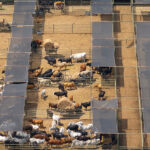The issue of when or how to lift social distancing and isolation is a wicked problem. A “Wicked Problem” in policymaking defeats standard solutions because of the interaction between the wicked problem and its potential solutions. The application of the correct solution to one aspect of the wicked problem often complicates another aspect of the problem. Solving wicked problems is best done through the iterative process in which a partial solution is applied, the problem is re-defined, the next partial solution is applied, and the process is repeated. This process is termed “Muddling Through”, and it is dependent upon the ability to test a partial solution and react to it.
The prospect of lifting social distancing is a wicked problem because a greater social association of the public will likely increase the number of infected persons. However, to not lift social distancing measures will worsen the economic recession and will not only exacerbate the deprivation of impoverished families, but also impair the eventual economic recovery due to bankruptcy of key businesses. A key ethical question is: Do lives serve dollars, or do dollars serve lives? The answer is not one or the other, but how to achieve a balance of both.
Influenza A vs. COVID-19
The infectivity of the severe acute respiratory syndrome coronavirus 2 (SARS-CoV-2) is expressed by the reproduction number or R0 (R-naught). The R0 expresses the average number of people a single person may infect. For example, an R0 = 1 would indicate that, on average, each infected person transmits the disease to 1 additional person. Although there are solutions to both the infectivity and economic recession problems caused by the coronavirus disease 2019 (COVID-19) pandemic, each solution complicates the other. The key decisions will be where, when, and how much to lift social distancing. To guide this process, a model of risk balancing may be useful. Fortunately, the seasonal influenza A serves as a model of risk balancing for a communicable, lethal infectious disease at a tolerable but still regrettable loss (see Table 1).
| COVID-19 | Influeza | |
| R0 | 2.2–2.7 (2.5) | 1.3–1.8 (1.6) |
| Case fatality rate | 3.0% | 0.1% |
| Vaccination effectiveness | None | 45% |
| Effectiveness of medical treatment | None | Variable |
| Deaths | N/A | 34,157 |
The propagation of viral disease is determined by its R0 until the disease runs out of persons to infect. For example, if 10 people are infected with SARS-CoV-2, they will infect 2.5 individuals making a total of 35 by the end of their two-week disease cycle. These 35 will then infect 2.5 individuals making a total of 122.5 by the end of the second two-week disease cycle, effectively increasing the number of infections by 10 times the original number in 4 weeks, 3.6 of whom would succumb to the disease. Unchecked, another four weeks would bring 1,225 infections with 36 deaths and so forth. Without vaccination or effective treatment, the best management strategies for COVID-19 are social distancing, isolation of infected persons, and quarantine of persons who were exposed.
Healthcare Workers vs. General Public
Essential workers such as healthcare workers demonstrate an interesting empirical experiment in opening the economy. Presumably, essential workers such as healthcare, law enforcement, emergency medical services (EMS), and other first responders use personal protective equipment (PPE) in their work. A recent Morbidity and Mortality Weekly Report (MMWR) publication documented the incidence of SARS-CoV-2 positive healthcare workers at 19%. There are 18 million healthcare workers in the United States, or approximately 5% of the population. While the rate of infection in healthcare workers is concerning, healthcare workers do expose themselves to a much greater number of infected people than other forms of employment. A SARS-CoV-2 positive rate of 19% among healthcare workers means that, even with PPE, lifting social distancing for a segment of the population incurs a greater risk of contracting the disease in that segment. One might reasonably expect the risk of contracting SARS-CoV-2 will be higher in the general public who would not have the compliance nor training to use personal protective equipment.
The rate of COVID-19 illness is not uniform across the United States. In locations with a high incidence of disease, lifting social distancing will clearly result in enhancement of the epidemic curve of disease. In some locations, this may be a return to a logarithmic growth of illness and death. However, in areas where there is low incidence of disease with good testing capability and public health surveillance, it may be possible to safely lift social distancing for a limited number of jobs. A surrogate model for reopening employment may be found in a recent MMWR on the incidence of SARS-CoV-2 positive testing among homeless shelters of various cities. The highest rate of SARS-CoV-2 positive was found in San Francisco (66%) and the lowest in Atlanta (4%). That study also documents a significant proportion of homeless shelter staff members infected (1-30%), presumably due to their occupation. This finding reinforces the MMWR report on the incidence of healthcare worker disease. Presumably, certain job types are at higher risk than others for disease exposure. Some occupations in the transportation and entertainment venues that require close association of people for prolonged periods of time may be unacceptably high risk until a vaccine, prophylactic medication, or effective treatments are developed.
In this scenario, the potential acceptable loss model from contagious infectious lethal disease is the nation’s experience with seasonal influenza A. To make the comparison more relevant, the vaccination effect for influenza must be considered and added back to the denominator of the at-risk population for COVID-19. Assuming that the 34,000 deaths are a result of a higher proportion of the unvaccinated segment (40%) of the population being affected and that the vaccine is 44% effective, the influenza case fatality rate may translate to as many as 46,196 deaths. This number would represent the empirical acceptable risk for COVID-19 modeling (see Table 2).
| Influenza case fatality rate | Vaccine effectiveness (VE) | Vaccine prevalence | U.S. population |
|
0.001 |
0.44 | 0.6 | 325,000,000 |
| Deaths with vaccination | 34,000 | ||
| Total cases with vaccination | 34,000,000 | Deaths/CFR | |
| Vaccinated population | 195,000,000 | ||
| Unvaccinated population | 130,000,000 | ||
| Infection risk without vaccine | 0.1421 | Total cases/(Vacc Pop* (1-VE) + Unvacc Pop) | |
| Infection risk with vaccine | Infectivity * (1-VE) | ||
| Total cases without vaccination | 46,195,652 | ||
| Deaths without vaccination | 46,196 |
Scenario: Lift Social Distancing on the Entire United States
In the estimation of COVID-19 case fatality, the best-case scenario is the empirical model of the case fatality rate of healthcare workers, and the worst is the prevalence of SARS-CoV-2 among homeless shelters (assuming no PPE use). Using the best-case infection rate of PPE-clad healthcare workers at 19% and a case fatality rate of 3% as constants, the maximum number of workers is 8,104,561 to achieve an acceptable yearly loss of 46,196 (see Table 3).
| COVID-19 case fatality calculator | ||||
| COVID acceptable loss | COVID case fatality rate | COVID infectivity rate | U.S. population | |
| 46,196 | 0.03 | 0.19 | 325,000,000 | |
| Maximum infected rate | 1,539,867 | |||
| Maximum number of workers | 8,104,561 | |||
| Percent of U.S. population | 2.5 | |||
The current number of medical personnel working is 18,000,000 (18 million). Assuming an approximately equal number of law enforcement, EMS, and essential commerce are working, or 36,000,000 (36 million), the U.S. has exceeded the maximum number of acceptable loss of workers predicted in the influenza A model* by about a factor of 4. If the homeless shelter empirical model with a much higher incidence of disease were used, the maximum number of workers that would result in the same acceptable loss would be drastically lower. Given that the COVID-19 healthcare worker model indicates this COVID-19 year already exceeds the theoretical unvaccinated influenza death total at the current level of social distancing, opening the economy without further exceeding the notional “acceptable loss” of life is challenging. The COVID-19 associated deaths would be accounted in multiples of the acceptable deaths attributable to influenza.
An alternative to the flu-based acceptable loss analysis is econometric, in which the loss of life is weighed against the value of the economic recovery. Although the best-case scenario is to recover the economy with no loss of life, that will not be possible without significant medical advances in the areas of effective treatment and/or vaccination. In the economic analysis, the use of a quality adjusted life year (QALY) is useful. One QALY = 1 year of life at perfect health. If one is disabled, one QALY is degraded by some fraction of loss of utility. The value of one QALY is generally around $50,000 (with a high of around $150,000). Applying the QALY concept to the economic valuation of loss of life due to COVID-19, the age of the victim determines the economic impact of the death. If a younger person dies from the COVID-19, the cost in QALY would be the difference in estimated life span and the age of the person multiplied by $50,000. For example, in a given area where life expectancy is 78 years, if an 18-year-old succumbs to the disease, the QALY value is:
- (78-18)($50,000) = $3,000,000.
Conversely, if a 68-year-old person succumbed to the disease, the QALY value is:
- (78-68)(50,000) = $500,000.
The 2019 GDP of the United States is about $21 trillion ($21,427,675,000) and has lost an estimated 5.3% or about $1.6 trillion ($1,665,666,775) in 2020. Because the COVID-19 case fatality rate trends strongly toward the elderly, the acceptable loss based on QALY valuation would be based on an average age of death (see Table 4). As of 6 May 2020, of 44,016 deaths, there are currently 18,214 COVID-19 deaths under the age of 75. By applying a life expectancy of 78 years at full utility to the COVID death by age distribution, there would be 284,785 years of lost life at a QALY value of approximately $14 trillion ($14,239,250,000).
| Average Age | QALY cost in current lives lost due to COVID-19 | ||
| N | Life span impact in years | QALY | |
| Under 1 | 4 | 310 | $15,500,000 |
| 2.5 | 2 | 151 | $7,550,000 |
| 10 | 4 | 272 | $13,600,000 |
| 20 | 48 | 2,784 | $139,200,000 |
| 30 | 317 | 15,216 | $760,800,000 |
| 40 | 796 | 30,248 | $1,512,400,000 |
| 50 | 2,262 | 63,336 | $3,166,800,000 |
| 60 | 5,422 | 97,596 | $4,879,800,000 |
| 70 | 9,359 | 74,872 | $3,743,600,000 |
| Total | 18,214 | 284,785 | $14,239,250,000 |
The current loss of life by QALY estimation is 14 times the economic losses in GDP, so this analysis does not support the lifting of social distancing and isolation. Further, a weakness of the econometric analysis is whose lives are lost for whose dollars. Given the disproportionate loss of life in poorer and minority communities, this approach can be offensive to those groups.
Perhaps the better question than “when to open” is “how to open” responsibly. In areas of low SARS-CoV-2 prevalence, in employment categories that can responsibly mitigate transmission risk by methods such as physically distancing workers or the use of PPE, and with public health monitoring, it may be possible not only to open segments of the economy, but also to quickly detect an increase in disease and re-impose social distancing. In this way, the economy may start and stop with good public health monitoring. To do otherwise is irresponsible.
*This model assumes that both the case fatality and occupational infectivity rate remains static. While there are COVID-19 deaths not accounted for in the model – including deaths at home or deaths prior to wide recognition of the syndrome – the likelihood is that the case fatality rate will fall when greater testing is available. With falling case fatality rate and increased ability to trace COVID-19 positive individuals and enforce their quarantine, the available work force will increase. Selected employment positions may have lower infectivity rate (e.g., clerical work), but some may be higher (e.g., entertainment, theaters, transportation). Public hygiene programs may mitigate these issues.

Galen Adams
Galen Adams, MD, Retired emergency medicine physician and Canadian Forces (Forces arm’ees Canadienne) veteran, Dr. Adams has served as a consultant to the Royal Canadian Mounted Police as well as the Canadian Forces Medical Services in the areas of civilian response to terrorism and disasters. He currently resides in Dodge City, Kansas. "Dr. Adams" is a nom de plume for a very well respected physician who is both known to DomPrep and is unable to affix actual byline to the article.
- Galen Adamshttps://domprep.com/author/galen-adams
- Galen Adamshttps://domprep.com/author/galen-adams

Jeremy L. Kim
Jeremy L. Kim
- This author does not have any more posts.






